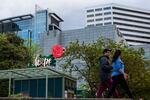For a generation now, urban planners have been pushing the idea of denser living.
Putting more people in less space is better for the environment, they have said. It spurs economic creativity. And, as denizens of walkable places can attest, it’s just a more pleasant way to live for many people.
But there’s one time when living closer to your neighbors doesn’t feel like such a great idea: Right now, in the middle of a worldwide pandemic.
"This is, for sure, a concern in urban planning that this experience will make people want to … sort of hunker down in their own homes," said Lisa Bates, an associate professor of urban studies and planning at Portland State University. "There's a worry that this will be an incentive for everyone to build a McMansion where all their kids can have their own room to be on their own tablet doing their own Zoom call."
In a public health crisis, cities pose unique dangers.
Critics of government-pushed density — people who want less bureaucracy and fewer restrictions on how property owners use their land — have long argued against the tighter land-use rules in places such as Oregon and Washington. Both states have policies that limit where new construction can go as a way to reduce suburban sprawl, preserve farmland and forests, and promote denser living.
The pandemic has amplified arguments against density and taken them mainstream. The New York Times, for example, recently quoted a Stanford University epidemiologist calling density "an enemy in a situation like this" in a story about why New York City is a coronavirus hotspot. The comparative safety of country living has been an undercurrent of the calls for governors to ease stay-at-home rules.
And it’s true: In the United States, the earliest flash points for COVID-19 were dense places: New York, Seattle, Detroit, Chicago.
But there are also major world cities — places where people are more tightly packed than any U.S. city — that have managed to flatten the coronavirus curve quickly.
"Let's look at some of the most dense places around the world that have been incredibly successful at understanding and addressing this issue … cities in China, [places] like Singapore, Taiwan, Seoul," said Jason Corburn, who runs the Institute of Urban and Regional Development at the University of California-Berkeley. "These are incredibly big mega cities, and they did things that curbed this much faster than we've managed."
When planning and public health intertwined
The shape of cities is a contributing factor, not the sole cause. Still, planners and other urban designers are taking this stay-at-home time to reconsider their work. They’re not pulling back from the push for more urbanizing lifestyles, but revisiting the policies and political decisions that led to certain aspects of this crisis.
“There’s an important but subtle distinction ... the difference between density and overcrowding,” said Corburn, who helps UC-Berkeley’s Center for Global Healthy Cities, a program that brings planning and public health students together.
“Density is very healthy: It supports social connection, human connection, access to green space, the things that keep us alive and happy and healthy. Overcrowding is unhealthy.”
Overcrowding is really where the U.S. system of regulating land use began.
“It comes out of the tenement slum era,” said Bates, whose work at Portland State focuses on housing and social justice. “People didn’t have light. They didn’t have air. They didn’t have water. They didn’t have sewers. You had highly polluting industries next to housing.”

The Ceru family makes artificial leaves in a tenement attic in New York City in January 1912. Modern urban planning was a product of overcrowding in tenement housing projects.
Lewis Wickes Hine / National Child Labor Committee collection, Library of Congress, Prints and Photographs Division.
The result was modern urban planning, new government and academic attention to how communities are built and how they’re regulated. The first modern urban planners and public health experts — the predecessors to the physicians and epidemiologists leading today’s COVID-19 response — worked closely.
"These two professions really emerged with the same goal in mind: to protect the public's health, well-being and safety," said Vivek Shandas, a Portland State University planning professor and founder of the school's Sustaining Urban Places Research Lab. "Eventually, they become less intertwined."
Public health shifted from basic sanitation — policies for dealing with day-to-day realities such as the need to safely dispose of sewage and garbage — to more complicated work preventing and identifying communicable diseases.
Meanwhile, planning in the United States became less about making cities safer and more about plotting out where and how America would build, sometimes in ways that ended up undermining public health.
Famed New York City public works czar Robert Moses and a generation of planners and builders used zoning laws and urban development agencies to raze inner-city neighborhoods and stretch highways to new suburbs.
Racism and xenophobia were underlying themes in that work. America’s new middle class sought space and value — bigger homes, bigger yards, two-car garages — in far-flung places. And in some cases, they also sought communities integration hadn’t yet reached. The ad campaigns for new suburban developments frequently pitched them as “cleaner” and healthier than city life.
“There’s a sincere and authentic conversation about cities and density,” Bates said. “Then there’s a very different conversation that goes to the heart of how we understand one another as people together in this country, and this kind of imagination that there are ‘real Americans’ in small towns or in the heartland, and they’re somehow impervious to this and that those bad people in cities are weak or live deviant lifestyles.”
Cleaner cities, but not for everyone
Over the past several decades, planners have pushed back against suburbanization, particularly suburban sprawl. They’ve promoted the idea that more urbanized living, when done well, is actually better for our physical and economic health. Planning has become intertwined with a different movement — environmentalism — as global warming became a more pressing threat and the impact of all that driving became more obvious. In Oregon and Washington, new suburbs resemble village centers rather than sprawling collections of cul de sacs.
Related: New Data Show Latinos In Oregon Are Still Disproportionately Affected By COVID-19
But COVID-19 is illustrating that the benefits of denser living — more walkable communities, shorter commutes, proximity to basic services — haven't arrived for everyone. Data show African Americans, Latinos and other communities of color have been hit harder by the virus in most parts of the United States. Even in New York City, COVID-19 struck worse in boroughs that tend to be more economically and racially diverse — the Bronx, Queens and Brooklyn — than whiter, richer Manhattan.
"It is disproportionately affecting Black communities and Hispanic communities in this country, and that's because of their underlying health issues because of their lack of access," said Lynn Peterson, president of the Portland area's Metro regional government. "So many of our populations have been isolated by the way we have created our communities."
Many Black and Latino neighborhoods sit long distances from grocery stores, hospitals, libraries and job centers. That didn’t happen by accident. In cities and towns across the country, zoning policies of the 20th century restricted where people of color and recently arrived immigrants could own homes or rent.
Related: Study: More People Of Color Live Near Portland’s Biggest Air Polluters
Redlining and urban renewal projects often drove groups without any political clout toward neighborhoods near highways or major industry — thus making them more likely to suffer the underlying health problems that increase vulnerability to COVID-19.
“Those communities are disproportionally impacted not just because they happen to be communities of color today,” Shandas said. “They’ve been living in places that have historically been polluted on, so their vulnerability to this is higher.”
Disproportionately high rates of coronavirus among communities of color aren’t, Shandas and other experts say, an indictment of our physical structures. Rather, they’re the result of structural racism.
“Obviously being in closer contact with other people is part of disease transmission, so public transit is a potential vector of disease transmission,” Bates said. “You look at pictures of the subway in New York City, and you see people still packed in who are ‘essential workers.’
“That’s problematic because there are a lot of people there, but I’d suggest the problem isn’t that we have a transit system. It’s how we define essential workers and the fact that so many of them are brown and black people who still need to travel long distances to their service jobs and they don’t have any kind of protective gear.”
Can crisis lead to improvement?
Planning experts don’t think COVID-19 will slow the rise of cities or of suburbs that feel more city-like.
“People will come back to mass transit,” Peterson said, “though they might wear masks when they do it.”

A person rides the MAX light rail Red Line train through downtown Portland, Ore., Thursday, April 29, 2020. Mass transit ridership has decreased during the COVID-19 pandemic, but many still depend on it to get around town.
Bradley W. Parks / OPB
She sees the prospect of positive change: Maybe more companies will promote working from home after this, for example, a step that could help efforts to cut greenhouse gas emissions. Perhaps all those people biking and walking will emerge from quarantine with a new understanding of why planners push to add more protections for bikers and pedestrians to busy streets. Portland leaders announced this week that they'll impose temporary rules on some city streets during the pandemic to make them safer for bicyclists and pedestrians; some will get new bike and walking areas, and some will be closed entirely to cars and trucks.
“I’ve heard people lamenting how tight sidewalks are,” Peterson said, laughing. “Now they want the larger, wider sidewalks we’ve all been crying for as planners for years.”
Scientists promise more pandemics, in part because rapid construction in wild places brings human beings in more consistently close contact with animals and thus makes them more susceptible to infection.
Shandas, from Portland State, said that if civic leaders learn the right lessons from this crisis, cities might actually become the safest places to be during the next pandemic. Denser spaces can make it easier to monitor people’s health and track exposure, communicate risks and prevention strategies, and rush protective gear and prescription drugs to outbreak hot spots.
“The knee-jerk reaction to this is one of like, ‘Oh my goodness, more people, more danger, stay away,’” Shandas said. “It’s far less about the city and more about the processes and the ways in which we're able to respond.”

People walk along the waterfront in Portland, Ore., Thursday, April 29, 2020. The word "hope" was placed on the neon rose sign in response to the COVID-19 pandemic.
Bradley W. Parks / OPB
The philosophical choices that will determine whether we’re better prepared for the next big health crisis have less to do with where we live than with how. Will Americans accept having their health care data more widely shared and their movements more regularly tracked so public health experts can spot the next health catastrophe before it goes global?
That’s going to be a hard sell, no matter where you are.